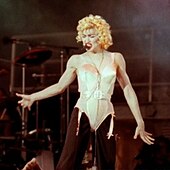팝 아이콘
Pop icon팝 아이콘(pop icon)은 대중 문화에서 노출이 특정 사회나 시대를 정의하는 특징을 이루는 것으로 간주되는 유명인, 캐릭터 또는 대상입니다.이 용어의 사용은 객관적인 기준이 없기 때문에 크게 주관적입니다.분류는 일반적으로 수명, 편재 및 구별과 같은 요소와 관련이 있습니다.게다가, "팝 아이콘"의 지위는 역사적인 인물들과 같은 팝 문화 외부의 다른 종류의 악명과 구별될 수 있습니다.몇몇 역사적인 인물들은 그들의 시대에 "팝 아이콘"의 지위에 오른 것으로 인식되며, 그러한 지위는 현재까지 이어질 수 있습니다.이전 시대의 팝 아이콘으로는 벤자민 프랭클린과[1] 모차르트가 있습니다.[2]
속성 및 원점

토론토 대학의 기호학 및 언어인류학 교수인 마르셀 대니시(Marcel Danesi)는 언어, 사회, 뉴미디어에서 다음을 인용했습니다. 사회언어학에서는 "아이콘"이라는 단어가 "종교적 기원의 용어이며 미국의 팝 가수 마돈나를 묘사하기 위해 연예인 문화에서 처음으로 사용되었다"고 합니다.[3]다음의 설명은 "현재 널리 알려진 유명인, 남성 또는 여성을 지칭하는 단어"라고 주장합니다.[3]옥스포드 고등 학습자 사전과 Diccionario panhispanico de dudas와 같은 세계의 몇몇 사전들은 "아이콘"의 새로운 의미를 설명하기 위해 마돈나의 이름을 포함시켰습니다.[4][5]
장수
일반적으로 유명인의 팝 아이콘 지위는 유명세의 장수 여부에 달려 있습니다.[6][7]이것은 컬트 아이콘들의 악명이나 인지도가 특정한 하위 문화에 국한될 수 있는 것과는 대조적입니다.일부 팝 아이콘들은 그들의 경력 영역에서 지속적이고 지울 수 없는 흔적을 남겼으며, 그 후 사회 전반에서 지속적인 인정을 받았습니다.[8]
유비쿼터스
팝 아이콘 상태의 일반적인 요소는 이미지의 보편성과 상징적 인물에 대한 암시입니다.[note 1]그 인물은 유명인의 원래 지위를 벗어난 지역에서 인정받고 심지어 기념되는 것이 일반적입니다.[note 2]이것의 예는 물리학자 알버트 아인슈타인인데, 그의 이미지와 유산은 만화, 티셔츠, 연하장 그리고 많은 다른 맥락들로 표현되어 왔습니다.[9]
구별
팝 아이콘 상태는 종종 사회적 이상이나 원형과 뚜렷한 연관성을 의미합니다.상징적인 인물들이 이런 연관성을 강조하기 위해 사용되는 별명이나 소브리케를 가지고 있는 것은 드문 일이 아닙니다.때때로 그러한 개인들의 이름은 심지어 일반적인 단어나 생각의 동의어로 사용되기도 합니다.
Some fictional characters, such as Peter Pan, Winnie the Pooh, Mickey Mouse,[10] Bugs Bunny, Tom and Jerry, Snow White, Superman, Batman, Spider-Man, James Bond, Darth Vader, Doctor Who, the Simpsons,[10] Harry Potter,[11] Mary Poppins, Mario, Kermit the Frog, SpongeBob SquarePants, Pikachu, Alice,[12] Willy Wonka,[13] and Sherlock Holmes are regarded as pop icons.심지어 무생물도 팝 아이콘으로 인식되어 왔습니다.[14][15][16]테일러 스위프트 같은 사람들도 팝 아이콘입니다.[17]
O.J. Simpson 재판과 같이 대중의 관심을 사로잡는 특정 사건에 대해 일시적이거나 맥락에 따라 "팝 아이콘"의 지위를 얻는 수치도 있습니다.[18]
참고 항목
메모들
참고문헌
- ^ a b Chaplin, Joyce (2006). The First Scientific American: Benjamin Franklin and the Pursuit of Genius. Basic Books. ISBN 0-465-00955-7.
- ^ Nettl, Bruno (1995). Heartland Excursions: Ethnomusicological Reflections on Schools of Music. University of Illinois Press. ISBN 0-252-06468-2.
- ^ a b Danesi, Marcel (2020). "4.1.3 Vocabulary". Language, Society, and New Media: Sociolinguistics Today. Routledge. ISBN 978-1-00-004876-6. Retrieved March 31, 2021 – via Google Books.
- ^ "icon". Oxford Advanced Learner's Dictionary. Oxford University Press. Archived from the original on June 4, 2020. Retrieved March 31, 2021.
- ^ "icono o ícono". Diccionario panhispánico de dudas (in Spanish). Royal Spanish Academy. 2005. Archived from the original on June 4, 2020. Retrieved March 31, 2021.
- ^ Dearborn, Mary V. (December 9, 1999). Mailer: A Biography. Houghton Mifflin Books. ISBN 978-0-395-73655-5.
- ^ Gottesman, Ronald; Brown, Richard Maxwell, eds. (1999). Violence in America: An Encyclopedia. Simon and Schuster. ISBN 0-684-80487-5.
- ^ Ratcliff, Ben (November 6, 2002). The New York Times Essential Library: Jazz: A Critic's Guide to the 100 Most Important Recordings. Times Books. ISBN 978-0-8050-7068-2.
- ^ a b c Kaku, Michio (April 2004). Einstein's Cosmos: How Albert Einstein's Vision Transformed Our Understanding of Space and Time. W. W. Norton & Company. ISBN 978-0-393-05165-0.
- ^ a b McNary, Dave (2011). "Icons of the century". Variety100.com. Variety. Archived from the original on August 15, 2011. Retrieved February 8, 2010.
- ^ Schmidt, Robert (February 24, 2004). "The 200 Greatest Pop Culture Icons". Blue Corn Comics website. Retrieved February 8, 2010.
- ^ Brooker, Will (2004). Alice's Adventures: Lewis Carroll in Popular Culture. New York: Continuum. p. xiv. ISBN 0-8264-1433-8.
- ^ "David Bowie Art Turns Singer Into Batman & Other Pop Culture Icons". Screen Rant. Retrieved 28 November 2022.
- ^ Vail, Mark (April 1, 2002). The Hammond Organ: Beauty in the B (2nd ed.). Backbeat Books. ISBN 978-0-87930-705-9.
- ^ Sheff, David (April 27, 1993). Game Over: How Nintendo Zapped an American Industry, Captured Your Dollars, and Enslaved Your Children. Random House. ISBN 978-0-679-40469-9.
- ^ "The Liberty Bell: From Obscurity to Icon". Teaching with Historic Places. National Park Service. October 16, 2006.
- ^ Levine, Nick (August 21, 2019). "Taylor Swift's Lover: The struggle to maintain superstardom". BBC. Retrieved October 29, 2021.
- ^ Boot, Max (1998). Out of Order: Arrogance, Corruption and Incompetence on the Bench. Basic Books. ISBN 978-0-465-05375-9.
추가열람
- Danesi, Marcel (2007). Popular Culture: Introductory Perspectives. Rowman & Littlefield. pp. 112–115. ISBN 978-0-7425-5547-1.
- 컬렌, 짐, 에드 (2001).미국역사의 대중문화.영국: 블랙웰 출판사.ISBN 0-631-21958-7.




